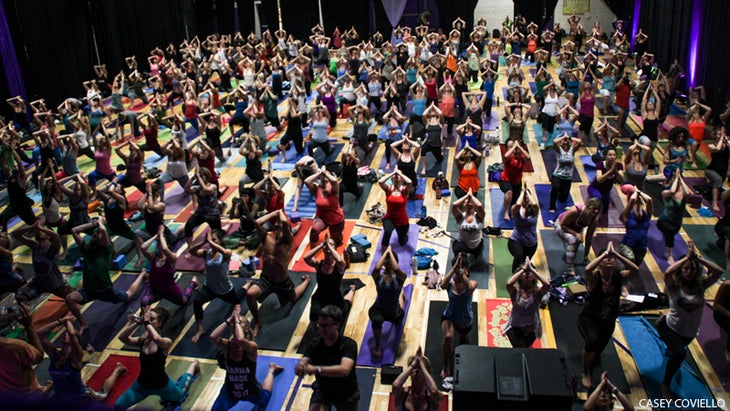Heading out the door? Read this article on the new Outside+ app available now on iOS devices for members! Download the app.

Leslie Kaminoff claims you should never say never about a yoga pose and that the key to safely teaching asana is actually shifting the focus to svadyaya.
Last time, we talked to anatomy expert and YJ LIVE! presenter Leslie Kaminoff (Can Wild Thing Ever Be Practiced Safely?), he asserted that asanas don’t exist separate from the individuals doing them. This time around, he makes another bold claim: “Asanas don’t have alignment, people have alignment.”
The Claim: Yoga Poses Don’t Have Alignment
Come again? This contradicts most of what most yoga teachers are taught in training—to look at the alignment of asanas intrinsically, breaking down each posture and then asking students (as a class) to build the pose from the foundation up. In other words, Warrior I has this alignment, Warrior II has that alignment, and so on and so forth through the entire syllabus of yoga poses. Kaminoff is attempting to change the conversation, though, by asking us to reimagine alignment as entirely based on the individual performing the pose. That is, “never say never” when teaching asana.
See also Patanjali Never Said Anything About Alignment
Never Say Never When Teaching Asana
According to Kaminoff, context is key. “Never” and “always” decontextualize any statement that follows. There are times when certain alignment cues apply for certain bodies in certain poses and other times when they don’t. There is no universally correct alignment—there is only correct alignment for an individual in a specific asana.
Kaminoff studied under T.K.V. Desikachar, son of Sri T. Krishnamacharya and author of The Heart of Yoga, who dedicated the majority of his life to teaching a highly individualized method of yoga, adapting the asanas, practice, and tools of yoga to the individual’s changing needs. “If I got nothing else from my studies with Desikachar, it’s the necessity to respect the individual in this process because the individual is the ultimate context of this yoga practice,” says Kaminoff, who doesn’t teach standardized asana to groups, but instead espouses a non-standardized, adaptable breath-centered approach to yoga.

Tailoring Group Classes to Meet Individual Students’ Needs
Since public group classes aren’t going anywhere any time soon, there has to be a middle ground between teaching the broad-stroke “safe” alignment cues and tailoring instruction to individual students’ needs. As an alignment-based teacher, I struggle with this in my classes. Having hypermobility in just about every joint of my body, myself, I learned the hard way that many of the alignment cues, aimed at the majority of the population who have flattened lumbar curves and tight shoulders, weren’t necessarily meant for me. To manage my super-flexible students, I often feel like I need to be giving two completely different sets of instructions throughout class. Sometimes it can be a lot to take on. In the end, as teachers, we do our best.
See also How to Teach Multi-Level Classes
Shift the Focus
“Yoga is not about doing the asanas—it’s about un-doing what’s in the way of the asanas,” Kaminoff likes to say. “In order for asana practice to truly be a yoga practice it has to be done in the context of understanding that we’re challenging our patterns while invoking svadhyaya, or self-reflection.” That is, rather than the end goal, it’s the process we’re after. All of the benefit and the greatest potential for change lies in the trying to both learn something about ourselves and to do something we couldn’t previously do.
See also How to Keep Your Yoga Classes on Track
Three Ways to Encourage Svadyaya in Your Students
- Create context for the physical practice, offering a theme, an intention or an attitudinal direction that that allows space for self-inquiry and contemplation.
- Probe your students to ask themselves questions, whether it relates to the physical experience of an asana (such as how can I create more freedom in this area of my body?) or to an internal experience that’s taking place (such as where does my mind go when I’m offered a moment of stillness? What track does it usually fall into?).
- When it comes to alignment of the poses, I like to remind my students to not take my word for it so-to-speak. I often ask them to try it my way, then try it their way, or whatever way a different teacher has asked them to do it—and then decide for themselves what makes sense to them and in their bodies.
See also 5 Questions for Yogis to Ask Themselves
Meagan McCrary is a 500 E-RYT and writer with a passion for helping people find more comfort, clarity, compassion, and joy on the mat and in life. She’s the author of Pick Your Yoga Practice: Exploring and Understanding Different Styles of Yoga, an encyclopedia of modern yoga systems. You can find her teaching and retreat schedule, along with her latest offerings at MeaganMcCrary.com, as well as on Facebook , Twitter and Instagram.